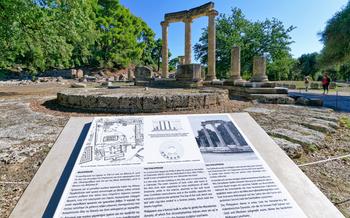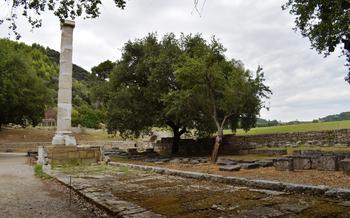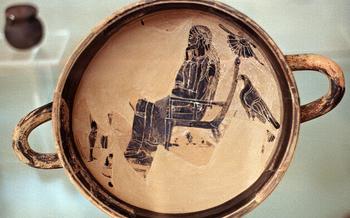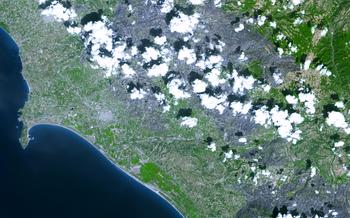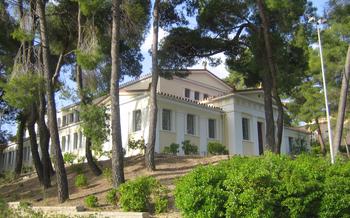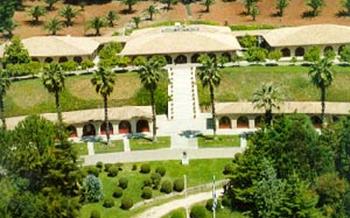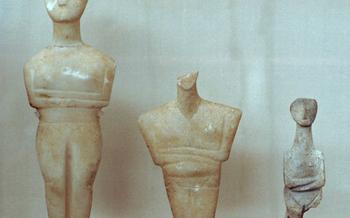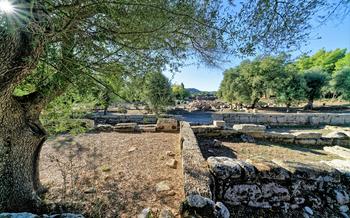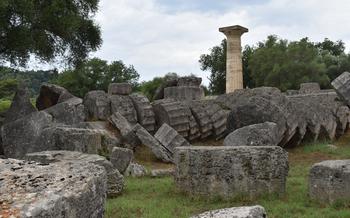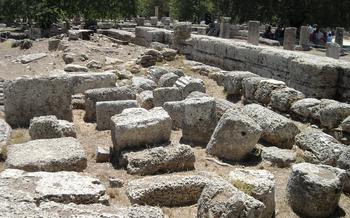
Prytaneion
- Olympia: A Historical Overview
- The Prytaneion: An Introduction
- The Hearth and the Sacred Flame
- Political and Civic Functions
- Religious Ceremonies and Rituals
- The Olympic Truce and the Prytaneion
- Banquets and Hospitality
- The Prytaneion as a Symbol of Greek Identity
- Excavations and Discoveries
- Visiting the Prytaneion Today
- The Olympic Games Today
- Tips for Visiting Olympia
- Insider Tip: The Secret Chamber
Olympia: A Historical Overview
Olympia, a sacred sanctuary in ancient Greece, holds a prominent place in history as the birthplace of the Olympic Games. This prestigious event, dating back to the 8th century BC, brought together athletes from across the Hellenic world to compete in a variety of sports, fostering unity and celebrating the human spirit. Olympia's significance extends beyond the games; it served as a religious center dedicated to Zeus, the king of the gods, and was home to magnificent temples, statues, and other impressive structures. In recognition of its exceptional cultural value, Olympia was designated a UNESCO World Heritage Site in 198Archaeological excavations conducted over the years have unearthed a wealth of artifacts and architectural remains, providing valuable insights into the history and significance of this ancient sanctuary. The site is divided into several distinct areas, each with its own unique character and function, inviting visitors to step back in time and experience the grandeur of ancient Olympia.
The Prytaneion: An Introduction
In ancient Greece, the prytaneion was a significant public building that served as the center of civic life and religious ceremonies. In Olympia, the Prytaneion held a prominent position within the sanctuary, adjacent to the Temple of Zeus and other important structures. This building embodied the unity and continuity of the city, playing a pivotal role in various political, religious, and social functions.
The Prytaneion's unique architectural features set it apart from other structures in Olympia. Its rectangular shape, divided into multiple rooms, reflected its diverse functions. The main chamber, known as the thalos, was the largest and most important space, featuring a central hearth that symbolized the city's unity and continuity. Surrounding the thalos were smaller rooms used for various purposes, such as dining, meetings, and storage.
The Prytaneion's prominent location and distinctive architecture made it a focal point of the sanctuary. Its proximity to other significant structures, such as the Temple of Zeus and the Pelopion, highlighted its importance in the religious and civic life of Olympia. This building stood as a testament to the city's commitment to preserving its traditions and honoring its gods.
The Hearth and the Sacred Flame
At the heart of the Prytaneion, a central hearth burned continuously, symbolizing the unity and continuity of the city. This sacred flame, meticulously tended by the prytaneis, was never allowed to go out. It represented the essence of the city's identity and served as a reminder of the enduring spirit of its people.
The prytaneis, who were responsible for tending to the flame, held a position of great honor and respect. They performed various civic duties, including managing the city's finances, overseeing legal proceedings, and organizing religious festivals. Their role in maintaining the sacred flame was considered crucial, as it symbolized the well-being and prosperity of the city.
The hearth was not merely a physical structure but also held deep religious significance. It was believed to be the dwelling place of Hestia, the goddess of the hearth, home, and family. By maintaining the sacred flame, the prytaneis were honoring Hestia and seeking her protection over the city and its inhabitants.
The hearth and the sacred flame were powerful symbols in ancient Greek society, representing the interconnectedness of the community, the continuity of tradition, and the devotion to the gods. They played a vital role in shaping the religious and civic life of Olympia and left a lasting legacy that continues to inspire and fascinate visitors to this day.
Political and Civic Functions
The Prytaneion served as a central hub for the political and civic life of Olympia. It was the meeting place for the city's council, known as the Boule, and other elected officials. The Boule was responsible for managing the city's affairs, including financial matters, legal proceedings, and religious festivals. The Prytaneion also hosted official banquets and ceremonies to honor distinguished guests and athletes who had achieved victory in the Olympic Games.
These functions played a crucial role in maintaining social cohesion and civic order within the community. The banquets and ceremonies provided opportunities for the city's leaders to come together, strengthen relationships, and make important decisions. The Prytaneion thus served as a symbol of unity and cooperation among the citizens of Olympia, fostering a sense of shared identity and purpose.
Religious Ceremonies and Rituals
The Prytaneion played a central role in the religious life of Olympia. It served as a sacred space where the community came together to honor the gods and seek their protection. Various religious ceremonies and rituals took place within the Prytaneion, each carrying deep symbolic and spiritual significance.
Central to these rituals was the tending of the sacred flame, which was never allowed to go out. The prytaneis, the officials responsible for the Prytaneion, held the duty of maintaining the flame, ensuring its continuous burning as a symbol of the city's unity and continuity.
Other religious ceremonies involved sacrifices, libations, and prayers. Animals were sacrificed, and their meat was offered to the gods as a form of worship and thanksgiving. Libations, offerings of wine or other liquids, were poured onto the ground or into a sacred vessel as a way of honoring the gods and seeking their favor.
The prytaneis led these rituals, ensuring their proper execution and adherence to religious traditions. They acted as intermediaries between the community and the gods, carrying out the sacred duties on behalf of the entire city.
These religious practices were deeply ingrained in the daily lives of the ancient Greeks. They provided a sense of connection to the divine and reinforced the community's shared values and beliefs. The Prytaneion, as the focal point of these religious ceremonies, stood as a testament to the spiritual and cultural significance of Olympia.
The Olympic Truce and the Prytaneion
The Olympic Truce was a sacred agreement observed throughout Greece during the Olympic Games, ensuring a period of peace and harmony. The Prytaneion played a crucial role in proclaiming and enforcing this truce. During the Olympic Truce, all conflicts and hostilities were suspended, allowing athletes and pilgrims to travel to and from Olympia safely. The Prytaneion served as the central authority responsible for disseminating the declaration of the truce throughout the Greek world. It was tasked with ensuring that all cities and states complied with the terms of the truce, creating a sacred space where competition and celebration could take place without the threat of violence. The Olympic Truce was not only a practical measure to facilitate the smooth running of the Games but also a powerful symbol of unity and cooperation among the Greek city-states. It reflected the belief that the pursuit of athletic excellence and the celebration of the human spirit should transcend political and military conflicts. The Olympic Truce, proclaimed and enforced by the Prytaneion, stands as a testament to the enduring power of sport to promote peace and understanding among nations.
Banquets and Hospitality
The Prytaneion was not only a center of civic administration and religious rituals but also a place of celebration and hospitality. Banquets and feasts were held to honor Olympic victors, foreign dignitaries, and other distinguished guests, showcasing the city's generosity and hospitality.
These banquets were lavish affairs, featuring an abundance of food and drink, as well as entertainment provided by musicians, dancers, and poets. The menu typically included roasted meats, fresh seafood, seasonal vegetables, and sweet pastries, accompanied by fine wines and aromatic herbs.
The banquets held at the Prytaneion were not merely social gatherings but also had political and diplomatic significance. They were used to strengthen relationships between Olympia and other Greek city-states, as well as to honor and reward individuals who had brought glory to the city.
By hosting these banquets, the prytaneis demonstrated Olympia's commitment to hospitality and its role as a welcoming and inclusive city. These events played a crucial role in fostering social cohesion, building alliances, and promoting peace and cooperation among the Greek city-states.
The Prytaneion as a Symbol of Greek Identity
The Prytaneion was not merely a building; it was a living embodiment of the ideals and values that defined ancient Greek civilization. As the center of civic life and religious ceremonies, it symbolized the unity and continuity of the community. The prytaneis, who tended to the sacred flame and performed other civic duties, were seen as guardians of these values and representatives of the city's identity.
The Prytaneion also played a significant role in shaping Greek art and architecture. The building itself was designed with careful attention to symmetry, proportion, and harmony, reflecting the Greek ideals of beauty and order. Motifs inspired by the Prytaneion, such as the hearth and the sacred flame, were frequently depicted in Greek pottery, sculpture, and architecture, serving as reminders of the building's importance in Greek society.
The enduring legacy of the Prytaneion is a testament to its profound impact on Greek culture and identity. Even today, the ruins of the Prytaneion stand as a symbol of the rich cultural heritage of Greece, inspiring awe and admiration in visitors from around the world.
Excavations and Discoveries
Archaeological excavations at the Prytaneion have unearthed a wealth of valuable artifacts and architectural remains that have shed light on its history and functions. Among the most significant discoveries are the foundations of the original building, which date back to the 6th century BCE. Excavations have also revealed the remains of a large hearth, which was used for cooking and maintaining the sacred flame. Numerous pottery fragments, inscriptions, and other artifacts have been found, providing valuable insights into the daily life and religious practices of the ancient Greeks.
Ongoing research and conservation efforts are helping to preserve and understand this important site. The Greek Archaeological Service has undertaken extensive restoration work to stabilize the ruins and protect them from further deterioration. Archaeological excavations continue to uncover new information about the Prytaneion, adding to our knowledge of this remarkable building and its role in ancient Greek society.
Visiting the Prytaneion Today
The Prytaneion is open to the public and visitors can explore its ruins and learn about its history and significance. The site is well-maintained and offers a glimpse into the daily life and rituals of ancient Olympia. Guided tours are available and provide a deeper understanding of the site and its importance. Visitors should be aware that some areas of the Prytaneion are still undergoing restoration work, but this does not detract from the overall experience.
It is important to remember that the Prytaneion is a historical site and visitors should respect its significance. Visitors should avoid touching or climbing on the ruins and should be mindful of their behavior. Photography is allowed, but visitors should be respectful of other visitors and avoid using flash photography.
Visiting the Prytaneion is a unique and rewarding experience. It offers visitors a chance to connect with the past and learn about the origins of the Olympic Games. The site is a reminder of the rich cultural heritage of Greece and its enduring legacy in the world.
The Olympic Games Today
The modern Olympic Games, inspired by the ancient tradition, were revived in 1896 and have since become a global phenomenon that brings together athletes from all over the world to compete in a spirit of friendship and sportsmanship. The connection between the ancient and modern Games is symbolized by the lighting of the Olympic flame at the Prytaneion in Olympia. This sacred flame is then carried by a torch relay to the host city of the Olympic Games, where it burns throughout the duration of the event.
The Olympic Games today represent more than just athletic competition; they embody the ideals of peace, understanding, and cooperation among nations. The Olympic Truce, which was observed during the ancient Games, is still upheld today, calling for a cessation of hostilities during the Olympic period. The Games also promote cultural exchange and foster a sense of global community, bringing people together from different backgrounds and nationalities to celebrate the human spirit.
Greece, as the birthplace of the Olympic Games, plays a crucial role in preserving the legacy of this ancient tradition. The country is committed to upholding the Olympic ideals and ensuring that the Games continue to inspire and unite people worldwide. Olympia, with its rich history and iconic landmarks, remains a living testament to the enduring power of the Olympic spirit.
Tips for Visiting Olympia
To make the most of your visit to Olympia, consider planning your trip during the shoulder seasons (spring or fall) to avoid the summer crowds and heat. Wear comfortable shoes and clothing suitable for walking on uneven surfaces, as the site is extensive and involves some uphill sections. Guided tours and audio guides are available to provide in-depth information and insights into the history and significance of the Prytaneion and other structures in the sanctuary. Remember to bring water, sunscreen, and a hat to protect yourself from the sun, as there is limited shade at the site. For a truly immersive experience, consider attending one of the many cultural events or festivals that take place in Olympia throughout the year, showcasing traditional Greek music, dance, and cuisine.
Insider Tip: The Secret Chamber
Beneath the main chamber of the Prytaneion lies a hidden chamber that was once used for secret meetings and rituals. This chamber was discovered during archaeological excavations in the early 20th century and is not accessible to the general public. However, if you are fortunate enough to be granted special permission to visit, you will be rewarded with a glimpse into the hidden mysteries of this ancient building. The chamber is adorned with intricate carvings and inscriptions that provide clues to the secret ceremonies that took place within its walls. It is a truly unique and awe-inspiring experience to stand in this hidden chamber and imagine the clandestine activities that unfolded here centuries ago.
